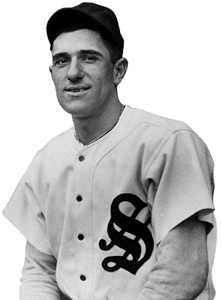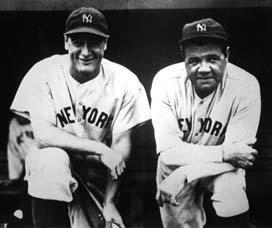By Sharon Boswell
and Lorraine McConaghy
Special to The Times
 John Miljus began the summer of 1927 as the "star hurler"
of the Seattle Indians, and ended it playing in the big leagues for
the Pittsburgh Pirates against the Yankees in the World Series. Photo Credit: Seattle Times.
John Miljus began the summer of 1927 as the "star hurler"
of the Seattle Indians, and ended it playing in the big leagues for
the Pittsburgh Pirates against the Yankees in the World Series. Photo Credit: Seattle Times.
THE '20S WAS THE DECADE OF BALLYHOO -- of silly crazes and outrageous stunts,
of flagpole sitters and marathon dancers. But no publicist dreamed up the thrills of 1920s sports
when superb athletes entertained fans in packed grandstands from coast to coast.
From the National Negro Baseball League to the Northwest Timber League,
Wimbledon to the Seattle Tennis Club, the dramatic contests of sport gave us heroes and
villains who became classic figures in American culture.
In tennis, Big Bill Tilden represented the United States
on the Davis Cup team every season from 1920 through 1930. The great golfers
Bobby Jones, Walter Hagen and Gene Sarazen dominated not only American courses
but the venerable British greens as well.
Red Grange played on three successive All-American
collegiate football teams. At Notre Dame, Knute Rockne coached his squad
to three national championships, powered by the famous Four Horsemen backfield.
Jack Dempsey held the heavyweight-boxing title from 1919 through 1926,
when he lost to Gene Tunney. In 1927, Dempsey and Tunney fought an epic grudge
match watched by more than 150,000 spectators at Soldier Field in Chicago.
Ballyhooed from coast to coast, the bout's gate was nearly $3 million -- big money.
But during the 1920s, baseball claimed America's heart.

At right, the epic Yankee lineup included "Iron Horse" Lou Gehrig and "Battling Bambino" Babe Ruth.
Photo Credit: The National Baseball Library and Archives.
WASHINGTON'S BASEBALL SCENE WAS LIVELY. The Northwest Semipro League
hosted games between Hahn's Sporting Goods and the Nippon Athletic Club, with its stars
Jimmy Okimoto and Kay Takayoshi. In the Timber League, the Everett Seagulls battled
the Aberdeen Black Cats for the 1927 title.
In Seattle itself, the Community League organized play among neighborhood teams,
such as the Alki Merchants and the Green Lake Club. But the city also boasted Commercial, Fraternal
and Church Leagues, and the Seattle Parks Department teams for boys and girls.
Daily, The Times devoted a four-page section to sports, lush with photos,
and written by old Times sports hands Cliff Harrison, John Dreher and George Varnell.
This was a glorious decade for sportswriting. "Sportslight," a column by celebrated
stylist Grantland Rice, was syndicated in The Times, and short story-writer Ring Lardner and essayist
Westbrook Pegler covered national sporting events like the World Series.
The newspaper sponsored the Fun Frolic tournament for kids' baseball
teams, as well as Old Woodenface's tour of the city's playfields. Old Woody was an "automatic umpire"
whose strike zone challenged the skills of Seattle's young hurlers.
In 1927, The Times hosted a semi-pro baseball tournament to determine
the Pacific Northwest championship. The Bellingham Tulips eventually beat West Seattle,
after a hard-fought series.
But Seattle's big baseball excitement centered on the Indians, of the Pacific Coast League.
Brick Eldred, Pid Purdy, Pel Ballenger, John Miljus -- everybody in town knew them.
The Tribe had won the PCL title in 1924, playing ball down at Dugdale Park
in the Rainier Valley. In April 1926, the Indians led a motorcade to the field for their opening stand
against the Portland Beavers. An overflow crowd of 13,000 packed the grandstand and bleachers;
Seattle's mayor-elect, Bertha Landes, stood behind the plate to umpire the game.
But that summer's weather was wet and chilly, the fans were fickle, and by season's end,
the Indians were in seventh place and the owners were talking about selling the team.
The following year, Seattle Indians pitching ace John Miljus boasted an ERA of 2.36,
the best record in the PCL. In July, he signed as a relief pitcher for the Pittsburgh Pirates,
contenders for the National League pennant. Ecstatic, Seattle declared a Miljus Day to honor "The Big Serbian,"
as Times sports scribes dubbed him, proudly reporting the line drives and shut-outs of "our big strapping boy hero."
Seattle had sent a crusader to the big leagues, but just as baseball created heroes and villains,
it also required fall-guys.
When the Pirates met the New York Yankees in 1927 to decide the World Series,
they faced the greatest line-up in baseball history, including Babe Ruth and Lou Gehrig.
That year, the two sluggers hit more than 100 homeruns between them.
Each day, 10,000 fans thronged Seattle's Times Square to follow the Series play-by-play on
The Times' automatic scoreboard. And the crowd rooted for the underdog Pirates and their hometown hero.
But the Yankees swept the Pirates in their first three games. In the fourth game,
with the score tied in the ninth inning, John Miljus came in as relief pitcher. He struck out
two hitters, but then the "Big Serb" threw a wild pitch with two outs and the bases loaded.
The catcher scrambled madly after the ball, and the Yankees' winning run trotted home. It was over.
John Miljus had been a hero on the Seattle Indians; he became the goat of the 1927
World Series. Times sports editor Cliff Harrison wrote a wise and gentle essay,
urging Seattle to welcome home this eager boy of summer whose curve ball got away.
Historians Sharon Boswell and Lorraine McConaghy teach at local universities and do research, writing and oral
history. Original newspaper graphics courtesy of the Seattle Public Library.